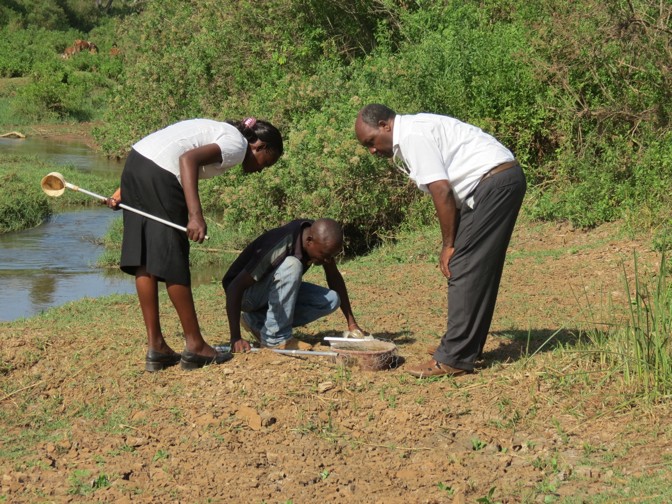When Delphine Thizy talks to people about eliminating malaria by targeting mosquitos, the one question she says everyone asks—“whether you’re talking to someone in a village in Africa who has never studied biology or an ecologist or a UN ambassador”—is this: What are the consequences?
It’s a good question. To humans, mosquitoes are at best annoying and at worst deadly, but to dozens of other species in the wild, they are competitor, pollinator, or prey. If past malaria-eradication campaigns have taught us anything (see: 1950s, DDT), it is that reshaping the environment can have unintended consequences.
Thizy talks about mosquitos because she is the stakeholder engagement manager for Target Malaria, a Bill Gates–backed nonprofit research consortium developing genetically modified mosquitoes to suppress populations of the bugs that spread the disease. The technology is ambitious and new, and thus controversial. Even though its genetically modified mosquitoes likely won’t be ready until 2029, Target Malaria has gotten enough questions about ecological consequences that it realized answering with the current scientific consensus—It will probably be fine!—was not good enough.
In October, a team of Target Malaria scientists from the University of Ghana and the University of Oxford will embark on a four-year study of the ecology of the malaria mosquito Anopheles gambiae in Ghana. Ultimately, they hope to understand how fish, bats, flowers, and insects would respond if those mosquito populations were reduced—or even entirely eliminated. Previous research has danced around this question, Thizy says, but “nobody has really studied it on purpose.”
The study will follow Anopheles gambiae from the larval stage to adulthood to death. First, the team will set up low-tech artificial breeding sites (i.e., small pools of water) to simulate the aquatic environment where larvae start their life. The key question, says Charles Godfray, a biologist at Oxford who is working on the study, is which competitors benefit when you take out Anopheles gambiae larvae: harmless insects, or other carriers of deadly disease?

There are more than 3,000 mosquito species in the world, of which 70 can transmit malaria. (Many others transmit diseases such as yellow fever, Chikungunya, Zika, etc.) Anopheles gambiae, a complex of eight closely related species, is the dominant vector of malaria. If targeting Anopheles gambiae means trading one malaria-carrying mosquito for another, though, that may not be much progress. This question of targeted elimination is newly relevant because of the possibility of Anopheles gambiae–specific genetic engineering, as opposed to indiscriminately murderous pesticides like DDT.
On the other hand, Godfray says, “Anopheles gambiae, it really is our mosquito. It really has evolved with us.” It lives near humans. It favors human blood more than virtually any other kind of mosquito. “It’s quite hard to think about what could replace it that is worse,” he added.
The study will also look at the animals that are eating mosquitoes. Bats, for example, are known predators. “We can go into a bat roost and we can collect the feces,” Godfray says. The team will actually analyze the DNA pooped out by bats with a technique called DNA barcoding, which uses short stretches of the genetic material to quickly identify specific species. The results will help the researchers determine what proportion of the bats’ diet is composed of Anopheles gambiae.
[Two ways of making malaria-proof mosquitoes]
DNA barcoding can also be used to track Anopheles gambiae as pollinators. Mosquitoes feed on nectar, and they pick up pollen as they fly from flower to flower. The team will collect mosquitoes, collect the pollen grains they carry, and use DNA barcoding to identity the plant species the pollen came from.
Everything scientists already know about mosquitoes suggests that eliminating Anopheles gambiae won’t majorly impact the ecosystem. Anopheles gambiae seems to make up only a small percentage of the diet for animals that eat it, and only a small percentage of the pollination for plants that rely on it, says Mamadou Coulibaly, a malaria researcher at the University of Bamako in Mali who has worked with Target Malaria on other studies. Still, he hopes this study will help people better understand and accept the work of Target Malaria. “We cannot take anything for granted,” he says, especially when working with such potentially powerful technology.
Target Malaria is careful to say its goal isn’t to eliminate all mosquitoes or even all malaria mosquitoes. Its goal is to eliminate malaria—and it is possible that simply suppressing Anopheles gambiae numbers is enough to break the cycle of transmission. Wiping entire mosquito species off the face of the Earth would be much harder, and maybe even a touch delusional.
Yet mosquitoes really don’t have many defenders, even among the scientists who know them most intimately. The idea of eradicating mosquitoes to stop malaria doesn’t particularly bother Steven Juliano, a mosquito-ecology researcher at Illinois State University. “It might be worth losing one species,” he says. “It might be worth it because the burden of human suffering is pretty high.”







